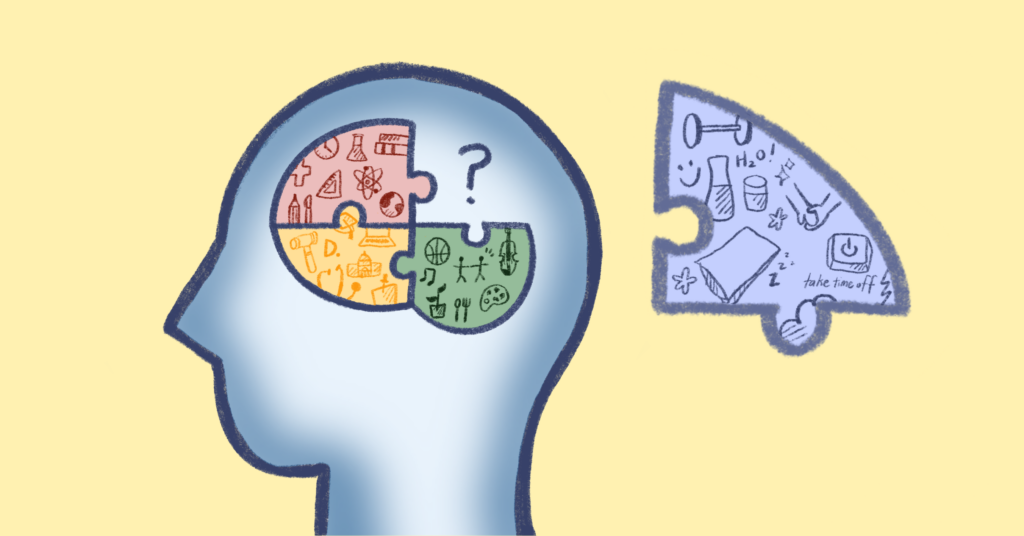Like countless other first-years, Vanesa Carrillo (MSB ’23) found herself carrying a lot of anxieties during her first weeks on the Hilltop.
“Freshman year, we’re all coming from different places around the world. And we’re all scared, we’re all in this bubble of shyness,” Carrillo told The Hoya.
Carrillo did not find herself stuck in this bubble for long, however, thanks to “Flourishing: College and Community,” a sociology course taught by professor Sarah Stiles. The course focused on wellness topics relevant to student life, such as preventing sleep deprivation and maintaining work-life balance.
Carrillo said Stiles’ course had a profound impact on her experience at Georgetown.
“The course really taught us how to express our feelings, how to define what’s a healthy routine as a student, and how to really grow as a person,” Carrillo said.
This course was made possible by the Engelhard Project, a Georgetown-specific educational initiative that connects academics and holistic well-being. Since its inception in 2005, the Engelhard Project has enrolled more than 19,200 students in nearly 500 courses led by over 100 faculty members. Approved courses follow a curriculum infusion approach, whereby faculty link course content to wellness topics through readings, presentations, reflective writing assignments and discussions led by campus health professionals.
The Engelhard project works to blend Jesuit values, academics and mental health while strengthening bonds between faculty and students in an innovative working environment.

At the Intersection of Mental Health and Academics
Engelhard Project courses like “Flourishing: College and Community,” have left a lasting impact on students and faculty alike.
For Carrillo, the reflective wellness activities built into the “Flourishing” course helped her craft a healthier, more sustainable schedule at a time when she was pushing herself to stay up late finishing assignments, often only sleeping four hours a night.
Students monitored their sleep and how it affected their overall mood and productivity. Carillo was able to build a stable schedule, getting eight to nine hours of sleep at night while still completing her work on time.
“It really helped me to define what my boundaries were as a student,” Carrillo said. “I’ve never seen another class actually do an exercise that will track your performance on something that’s not school related.”
Now a senior majoring in marketing, Carrillo has managed to maintain a balanced sleep schedule and keeps in touch with her mental health through regular journaling, a habit she picked up in Stiles’ course.
“It has carried me through senior year and what I can say has been a successful four years for me,” Carrillo said. “I owe a lot to the professors that encourage us to branch out and do something unique.”
The Engelhard Project doesn’t just benefit the students; for Stiles, teaching an Engelhard class has allowed her to critically examine her own wellness practices.
“If I’m going to be talking about the importance of sleep, well, I better be sure I’m getting some sleep,” Stiles told The Hoya. “If I’m going to be talking about the value of meditation? Well, I should be doing that. I should be getting physical exercise, I should be knocking off and then spending time with my outside relationships. And so I do, and I feel good.”
Meditation practice allows for a moment of reflection amid a busy day, said Stiles
“Students learn a new way of experiencing the world,” Stiles said. “I will begin class with meditation. I’ll ask them how they are, I will begin class by having them in small groups asking each other how they are and checking in. This emphasis from me as the professor gives them space to be a whole person, not just a student taking sociology at two o’clock in the afternoon.”
Professor Kathleen Maguire-Zeiss, whose neuroscience course is part of the Engelhard Project, said the framework facilitates meaningful connections between professors and students.
“As scientists, sometimes we look at what we’re teaching as the subject matter, and the data,” Maguire-Zeiss said in an interview with The Hoya. “This has really changed how I give information, and how I see the receiver, which is the student.”
Transformations in student-teacher relationships are an intended effect of the Engelhard Project.
“This curricular approach enhances academic learning, encourages students to reflect on their own attitudes and behaviors, and fosters faculty, staff, and student connections both in and out of the classroom,” the website reads.
Previous wellness topics covered by Engelhard courses include adjusting and transitioning to college life, anxiety, coping mechanisms, depression, eating disorders, emotional intelligence, healthy relationships, mindfulness, mood regulation, self-forgiveness, sexual identity, sexual violence, sleep deprivation, substance abuse, suicide and stress, among others.
Engelhard professors commonly partner with staff across a variety of centers on campus, including Counseling and Psychiatric Services, Health Education Services and the LGBTQ Resource Center. Such partnerships serve to deepen students’ understanding of relevant wellness topics and introduce students to valuable resources that can benefit them throughout their time at Georgetown.
Professor Sarah Vittone, who teaches an Engelhard course called Healthcare Managerial Ethics — a health care management and policy class — recently brought a licensed social worker from Georgetown MedStar Hospital to talk to her students about Stress First Aid, a framework designed to improve recovery from stress reactions in oneself and in coworkers.
Managing high-pressure situations is critical for students who intend to become health care managers and executives.
“They have to understand that there are going to be doctors and nurses working under them. They need to understand that level of stress, and how important it would be to put something like this program into practice in their organizations,” Vittone said in an interview with The Hoya. “From an ethical leadership perspective, caring for your employees is important.”
According to Vittone, approaching academics with a well-being lens helps students reach their full potential and feel supported.
“They talk about how they were happy to have the trust and confidence in their classmates that they could open up,” Vittone said. “And then also realize that there is a lot of pressure. And that it’s a social construction. All this stuff that’s coming at them, It’s not natural.”
The History of Engelhard
The creation of the Engelhard Project strives to bring the whole student into the classroom and support their academic and personal growth.
Supported by a grant from the Bringing Theory to Practice Project, an organization of educators who fund holistic higher education initiatives, the Engelhard Project began in 2005. A group of faculty and Division of Student Affairs staff pursued their interest in exploring connections between academia and students’ broader life experiences, particularly regarding physical and emotional well-being.
“Georgetown’s thinking was that by intentionally integrating well-being issues into courses, we could enhance student learning and well-being,” Jocelyn Schultz Lewis, the Senior Associate Director for Inclusive Teaching and Learning Initiatives at the Center for New Designs in Learning and Scholarship, wrote in a statement to The Hoya. “We want to support our students to be in a position to be their best and do their absolute best work.”
In 2012, the Project was endowed through a gift from the Charles Engelhard Foundation, a grant-making organization that supports projects relating to education, wildlife conservation, medicine and religion. The Foundation is a donor to Georgetown University more broadly, having given $2 million to the University since 2010.
Today, the Engelhard Project has expanded to include two grants programs and a faculty conversation series on teaching. The project has grown from featuring five or six courses each semester to an average of 35 to 40, according to Shultz Lewis.
To create an Engelhard course, a faculty member identifies a well-being topic that connects to course content and works with a campus resource professional (CRP) to facilitate a class session on that topic, Shultz Lewis wrote.
“This pedagogical partnership between faculty and campus resource professionals is still the core model we use in most Engelhard courses.”
Professors can become Engelhard Faculty Fellows by filling out a course proposal form and submitting a copy of their syllabus. The standard model for implementing an Engelhard module into a class includes a course-related reading, an in-class visit by a CRP, and a written reflection.
Courses selected for the project span a broad range of academic disciplines, ranging from business management to neuroscience to the performing arts. Creative approaches to curriculum infusion are highly encouraged.
“From the beginning of the project, we have tried to encourage wide and expansive thinking about what well-being topics could be included and each semester brings more creativity around the topic and faculty-CRP collaborations,” Shultz Lewis wrote.
After nearly 10 years of using the Engelhard model in her classes, Maguire-Zeiss said she can better understand her students’ struggles.
“I can generally tell by this point in the semester when a student shows up and they’re just not feeling it. So then I don’t hesitate to just reach out and say, ‘How are you doing today?’ That’s changed quite a bit from before,” Maguire-Zeiss said.

Wellness as a Georgetown Value
The Engelhard Project, is rooted in Georgetown’s Jesuit value of cura personalis, meaning care for the whole person.
“Through the intentional integration of well-being issues in the academic context, faculty and CRP partners are working to honor and validate the complexity, richness, and complications of student lives, modeling what it looks like to bring our whole selves to the classroom so that students can find their own way to do that as well,” Shultz Lewis wrote.
Stohr said being open and accommodating towards others is one of the hallmarks of Jesuit education.
“There’s a sense of meeting people in whatever space they’re in. And I think in the context of teaching, that just means that everybody, when they come into the classroom, has a lot of stuff going on,” Stohr said.
Maguire-Zeiss said Engelhard supports Georgetown’s focus on academic excellence.
“It’s not subtracting anything away from what we’ve been doing. We’re actually adding more information practically, about how these things are going to play out in your daily life,” Maguire-Zeiss said. “Even for your own health, it plays an important role. So I think it’s part of that education of the whole person.”
Ibrahim sees the program as an opportunity for educators to meet students’ needs amid changing social and political landscapes.
“What does it mean to care for the whole person? The mission is the same over time, but what that means in a specific time is different,” Ibrahim said. “At different times for different people, the thing they need the care for might change, and it might shift. And so as educators, we need to constantly be aware of what’s going on, not just because of how it affects us and how it might affect our teaching, but how it’s going to affect the young people who we’re coming into contact with.”
Ultimately, for students like Carrillo, Engelhard is above all heuristic, capable of teaching the skills necessary to thrive in a high-pressure academic environment that can be as challenging as it is rewarding.
“I think it’s the biggest component that made a difference in my education,” Carrillo said. “It built a structure for me.”
Today, Carrillo mentors first-years in the Georgetown Scholars Program (GSP), which provides resources and support to current and prospective first-generation and low-income students.
“Taking an Engelhard class is something that I honestly recommended day one to my mentees,” Carrillo said. “I was like ‘guys, you have to take an Engelhard class, it is going to help you become a better person, but also a better student.’”







